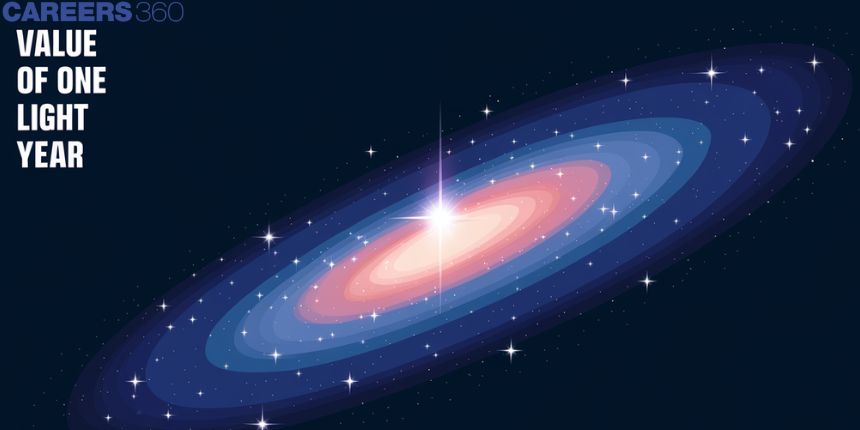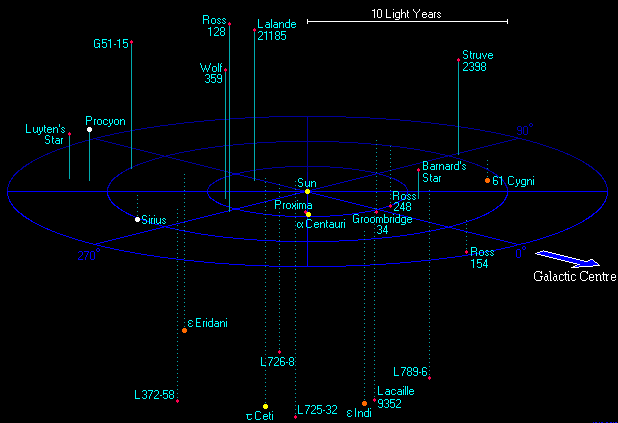Value of One Light Year - What is Light Year, FAQs
In this article we will talked about the light year, what is light year, value of one light year in Km, light year definition, 1 astronomical unit also conversion of light year into Km, conversion of astronomical unit in km, miles to km.
Light year or light year meaning
The light year or what light year is, measure of distance. It is amount of light travel through space in one year or the distance that light waves travels in one year. One light year is equal to the distance travel by the light in one year. Light year is used to measure distance.
1 light year in km is equal to 9,460,000,000,000,000 km; this is distance travel by light in one year.
1 light year in days is equal to 365.25 days
1 light year is equal to nearly one year.
Distance between earth and sun in light years is equal to 1.58 × 10-5 light years. In minute, it takes 8.3 minute to reach light from sun to earth.
Also read -
- NCERT Solutions for Class 11 Physics
- NCERT Solutions for Class 12 Physics
- NCERT Solutions for All Subjects
JEE Main 2025: Physics Formula | Study Materials | High Scoring Topics | Preparation Guide
JEE Main 2025: Syllabus | Sample Papers | Mock Tests | PYQs | Study Plan 100 Days
NEET 2025: Syllabus | High Scoring Topics | PYQs

What is a light year?
The fastest speed we know is moving through the light at 186,000 miles, or 300,000 km / s, in empty space. Given its speed, light can travel around the Earth about seven times per second. Use the speed of light to measure the distance to objects in space. A light year is the distance that light travels in a one year. In a one year, light wave travels roughly 5,880,000,000,000 miles, or 9,460,000,000,000,000 km and this is called as the 1 light-year, for example, the nearby star to earth is about 4.3 light-years far, our galaxy which is called as the Milky Way, is almost 150,000 light-years across, and the closest largest galaxy, Andromeda, is situated at a distance of 2.3 million light years.

The IAU specifically defines a light year. It is the multiplication of the Julian year (365.25 days which is more than to 365.2425 days in the Gregorian calendar) and the speed of light. Both of these values are added in the IAU Astronomical Constants System (1976), which has been in use since 1984. Hence, we can conclude about the following transformations. The IAU's recognized light-year abbreviation is ly, although other standards such as ISO 80000 use “l.y.” and localized abbreviations as often as “al” in French (from année-lumière), Spanish (from light years), and Italian (from anno luce), "Lj" in German (from Lichtjahr), etc.
1 light year = 9460730472580800 meters (exact)
≈ 9 461 petameters
≈ 9 461 billion km (5.879 billion miles)
≈ 63241077 astronomical units
≈ 0.306601 parsec
Until 1984, the tropical year (non-Julian year) a (unknown) measure of the speed of light included in the Astronomical Constant System of the IAU (1964) used from 1968 to 1983. The mean value of Simon Newcomb's tropical J1900.0 years is 31556925.9747 stellar seconds, and the speed of light is 299792.5 km / s gives light a year of 9.460530 × 1015 m (rounded to seven significant figures relative to the speed of light) are found in various modern sources.
Other high precision values are not derived from the IAU Harmonized System. The value of 9.460536207 × 1015 m found in some modern documents is the product of the average Gregorian year (365.2425 days or 31556952 seconds) and the speed of light (299792458 m / s). Another value, 9.460528405 × 1015 m, is the product of the average tropical year J1900.0 and the specific speed of light.
Abbreviations used for light years and multiples of light years:
• "ly" for a light year (ly full form)
• "kly" for a kiloliget (1,000 light years)
• "Mly" for a mega year (1,000,000 light years)
• " Gly "in one giga-year (1,000,000,000 light years)
Related Topics Link,
- Accuracy Precision Measurement
- Physics Symbols
- Unit of Length
- Error Significant Figures Rounding Off
- Unit of Volume
Define Astronomical Unit
An astronomical unit (Au) is a unit of length approximately equal to the distance from the Earth to the Sun. One astronomical unit is 149,597,870,700 meters (about 150 million kilometers or 93 million miles). One light year is equal to 63241077 astronomical units.
| Astronomical | meter |
| 0.01 AU, UA | 1495978706.91 m |
| 0.1 AU, UA | 14959787069.1 m |
| 1 AU, UA | 149597870691 m |
| 2 AU, UA | 299195741382 m |
| 3 AU, UA | 448793612073 m |
| 5 AU, UA | 747989353455 m |
| 10 AU, UA | 1495978706910 m |
| 20 AU, UA | 2991957413820 m |
| 50 AU, UA | 7479893534550 m |
| 100 AU, UA | 14959787069100 m |
| 1000 AU, UA | 1.49597870691E+14 m |
| Astronomical | kilometer |
| 0.01 AU, UA | 1495978.70691 km |
| 0.1 AU, UA | 14959787.0691 km |
| 1 AU, UA | 149597870.691 km |
| 2 AU, UA | 299195741.382 km |
| 3 AU, UA | 448793612.073 km |
| 5 AU, UA | 747989353.455 km |
| 10 AU, UA | 1495978706.91 km |
| 20 AU, UA | 2991957413.82 km |
| 50 AU, UA | 7479893534.55 km |
| 100 AU, UA | 14959787069.1 km |
| 1000 AU, UA | 149597870691 km |
| Astronomical | parsec |
| 0.01 AU, UA | 4.8481368111358E-8 pc |
| 0.1 AU, UA | 4.8481368111358E-7 pc |
| 1 AU, UA | 4.8481368111358E-6 pc |
| 2 AU, UA | 9.6962736222716E-6 pc |
| 3 AU, UA | 1.45444E-5 pc |
| 5 AU, UA | 2.42407E-5 pc |
| 10 AU, UA | 4.84814E-5 pc |
| 20 AU, UA | 9.69627E-5 pc |
| 50 AU, UA | 0.0002424068 pc |
| 100 AU, UA | 0.0004848137 pc |
| 1000 AU, UA | 0.0048481368 pc |
The dimension of a light-year:
From the above readings, we conclude that a light-year is the speed at which light can travel through space. This means that we are talking about the distance light travels between two astronomical objects. As we know, the length or distance dimension is [M0L1T0]. Likewise, the light-year size is [M0L1T0].
If we look at the value of one light-year in kilometers, miles, and astronomical units, they are all units of distance, and they all have a length dimension. So, whatever units we take, the size of the light-year will remain the same. Let's look at the light-year values in different units
Also Read:
- NCERT solutions for Class 11 Physics Chapter 2 Units and Measurement
- NCERT Exemplar Class 11 Physics Solutions Chapter 2 Units and Measurement
- NCERT notes Class 11 Physics Chapter 2 Units and Measurement
Conversion of different units of the Distance
| 1 centimeter | 10 mm |
| 1 meter | 100 cm |
| 1 meter | 1,000 cm |
| 1 kilometer | 1,000 meters |
| 1 kilometer (km) | 10 Hectometers (hm) | 1000 m |
| 1 Hectometer (hm) | 10 Decameters (dcm) | 100 m |
| 1 Decameter (dcm) | 10 Metres (m) | |
| 1 Meter (m) | 10 Decimetres (dm) | 100 cm |
| 1 Decimetre (dm) | 1000 mm | |
| 1 decimeter | 0.1 meter | |
| 1 Centimeter (cm) | 10 Millimetres (mm) | |
| 1 centimeter | 0.01 meter | |
| 1 millimeter | 0.001 meter |
Other Units
| 1 mile | 1760 yards |
| 1 mile | 5280 feet |
| 1 yard | 3 feet |
| 1 foot | 12 inches |
Also check-
- NCERT Exemplar Class 11th Physics Solutions
- NCERT Exemplar Class 12th Physics Solutions
- NCERT Exemplar Solutions for All Subjects
NCERT Physics Notes:
Frequently Asked Questions (FAQs)
Quantity that can be measured by some means is called a physical quantity.
A certain basic standard, arbitrarily chosen and accepted at the international level for measuring physical quantities, is called a unit.
The stars are made up mostly of hydrogen and helium, and only a small percentage of everything else: water, carbon, iron, etc. “Remaining all” is all made from mainly space dust, so we can generally say that all stars are comprised of gas and dust; however, stars are so high in temperature that all the dust in a star could have evaporated during its formation, so all matter in any star is now completely gaseous.
Distances to "nearby" stars (within a few hundred light years) are measured in parallax. A light year is the measure of distance that light travels in one year, which is nearly equal to 9.5 trillion kilometers (about 63,240 AU). The sun is 8.3 light-minutes away, and the next closest star, Proxima Centauri, is 4.2 light-years away.
Also Read
17 Nov'24 02:39 PM
12 Nov'24 11:26 PM
12 Nov'24 11:25 PM
12 Nov'24 09:36 PM
12 Nov'24 09:25 PM
12 Nov'24 06:03 PM
12 Nov'24 02:15 AM
12 Nov'24 01:39 AM
12 Nov'24 01:06 AM
12 Nov'24 01:05 AM